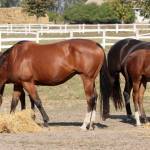Drylots for Managing Fat Horses and Ponies

As the name implies, drylots contain little fresh forage for horses to consume. Because of this defining characteristic, these barren plots have become valuable in the war against obesity in horses.
Drylots come in all sizes but are generally perceived to be larger than an average stall and spacious enough to allow some freedom to move. Some drylots comprise several acres.
Points to consider when implementing a drylot into a management plan for overweight horses and ponies:
• Feed forage. Hay is often fed in haynets or safe feeders designed especially for horses. Owners should avoid throwing hay directly on the ground, especially in sandy regions where sand colic is a known problem. Heavyweight mats may be used to keep hay off the ground, reducing the likelihood of sand ingestion and eliminating trampling of fallen hay. A mat can be used under a haynet as well to make cleanup easier.
“Appropriate hay for overweight horses and ponies must be found. Generally, this is not top-of-the-line forage, but clean, good-smelling mid-quality hay,” said Catherine Whitehouse, M.S., a nutrition advisor at Kentucky Equine Research (KER).
“Begin by feeding hay at about 1.5% body weight and then re-evaluate intake as often as necessary, increasing or decreasing hay as body condition dictates,” advised Whitehouse. Horses on an all-forage diet should be fed a vitamin and mineral supplement to adequately round out the ration, such as Micro-Max, developed by KER and available in the U.S. For horse owners in Australia, choose Nutrequin SE or another product from the vitamin and mineral collection.
• Provide ample water and salt. An appropriate water source should be available in the drylot, and should be checked daily.“Horses with access to pasture derive some of their daily water requirement from moisture-rich grasses,” said Whitehouse. “Because most drylot-kept horses are fed dry forages, it is important keep water fresh and clean at all times, as these horses might actually drink more than those on pasture.” Many horses will not drink extremely dirty water, and this could eventually lead to dehydration, colic, or other health concerns.
Place a salt block in the drylot. Containers are available for purchase that raise the block off the ground and allow rainwater to escape through predrilled holes. If placed directly on the ground, the block might pick up flavors from the ground and cause horses to cut back on consumption.
• Curb boredom. Spending a great deal of time in a drylot often causes horses and ponies to look for alternate forms of entertainment, which may include the development of certain vices such as wood-chewing. In addition to this, they might acquire an unusual appetite, called pica, and ingest tree bark, stones, and other nonnutritious items plucked from the environment.
When monotony sets in, some horses turn to the salt block for diversion, endlessly licking and biting it. If this is the case, allow the horse access to the block for an hour or so a day and then remove it.
Boredom will induce horses to eat plants they normally wouldn’t, so keep drylots free of weeds and other undesirable plants.
• Offer shelter. If a drylot is used to house horses for long periods of time, a shed or other kind of relief from extreme sun and other unpleasant weather conditions should be available. When planning a shelter, consider the lay of the land as well as the number of horses expected to share the area. Though three-sided shelters, or run-in sheds, spring immediately to mind, there are many different types of shelter suitable for horses.
• Manage manure. Depending on the size and stocking rate of the drylot, thoughtful manure management might be necessary. Picking up manure and placing it away from the drylot will not only keep the drylot clean but will provide two additional benefits: reduced fly population and diminished chance of recurring internal parasite problems.
• Inspect hooves regularly. Conscientious management dictates that hooves are cleaned and examined daily. This is particularly true if horses are barefoot and confined to a drylot, especially a sandy one. Hooves might require extra attention from a farrier during periods of confinement, as natural wearing patterns might change.
• Beyond the drylot. Management of grass outside of the drylot is just as important, as horses and ponies relegated to confinement are often inventive in their attempts to reach forage beyond the fence. A horse-friendly herbicide to can be used to keep forage from encroaching on fencelines, or electric tape or wire can be strategically employed to discourage reaching through a fence.








